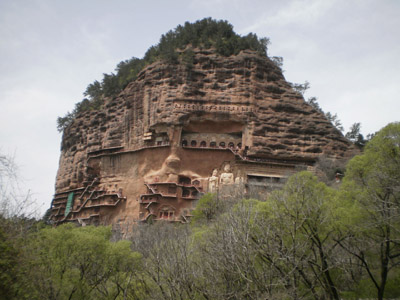 |
Looking like a “wheat stack”, the name is derived from a folk saying “Chop away firewood on the Southern Hill to get the Wheat Stack Cliff built up”. The Maiji Hill enjoys a typical Danxia (a wind-eroded formation) morphology. Rising abruptly from ground the hill stands 150 meter high in a secluded area of all greens. As early as the end of the Western Han Dynasty here used to be the summer resort of a well-known general Wei Xiao by name.
The Maiji Hill Grotto is the most grotesque one of all grottoes in China. Disposed perpendicularly on the cliff, the most renowned of them are the Seven-Buddha Pavilion and Ten-Thousand-Buddha Cave and some others. They are connected with plank-board passages and stairs, a breathtaking project that set the hearts of the people in their mouths when mounting. Elegant and graceful the grotto-art at the Maiji Hill features mainly of clay sculptures, the artworks being in a transitional period from the early Northern Wei to those of the Tang Dynasty, a medley of all styles of the time. In existence here are 194 caves overhanging on the southern side of the cliff with more than 7,200 stone carvings and clay sculptures and over 1,300 square meters of murals housed in them. The contents tell a thorough reflection of secular world with a rich expression of everyday life. Therefore, they are of very high artistic value and renowned as the “Museum of the Oriental Sculpture”.
Cited from:(Han Rongliang & Han Zhiyu (2006). Guide to Gansu [M].Beijing: China Travel and Tourism Press)


